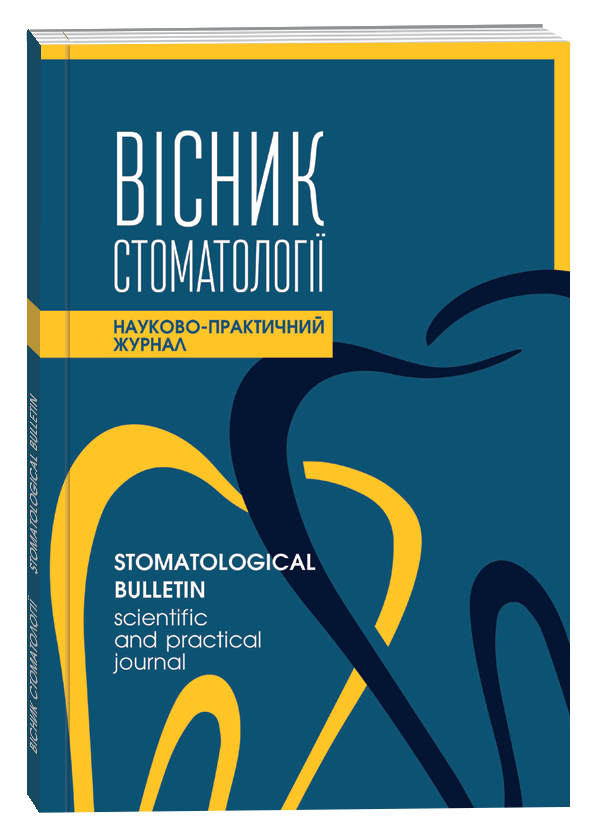THE CLINICAL EVALUATION OF THE TOOTH-JAW SYSTEM AT PATIENTS WITH CLINICAL DISORDERS OF THE TEMPOROMANDIBULAR JOINT
Keywords:
dysfunction syndrome of temporomandibular joint, dentition defects, clinical examination, prosthetic treatmentAbstract
Aim. The main purpose of our research is to improve the effi-ciency of diagnosis and treatment at patients with dentition de-fects and functional disorders of the temporomandibular joint with a help of improvement, development and clinical justifica-tion of complex measures based on individual approach to the patient.
Research methods. During the examination of patients with dentition defects and disorders of the temporomandibular joint we have studied the location of dention defects and the degree of atrophy of the alveolar bone. Besides, we have conducted the analysis of diagnostic models and radiographic tomography. The most valuable method of diagnosis of the temporo-mandibular joint is condylography. During our research we have examined 160 patients with dention defects, aged from 25 to 65 years.
Results. Among 120 patients of two groups during the detailed examination we found the TMJ dysfunction syndrome at (102) 85.0 % of patients and arthrosis of the TMJ at (18) 15.0 % of patients. The most common complaints among our patients were complaints for headache (85 %), pain of the TMJ (85 %), pain during movements of the mandible (72.5 %), pain during wide opening of the mouth (77.5 %), clicking in the temporomandibular joint (32.5 %), hearing loss (6.7 %) and feeling of stiffness and pain at gum muscles (68.3 %). An objec-tive examination showed us the clinical manifestation in the form of S-shaped lowering of the mandible, sagittal and trans-versal limit of the mandible movements. One of the most charac-teristic features of osteoarthrosis was morning stiffness of the lower jaw, which was observed at all 18 patients.
Based on our results we proposed methods and sequence of treatment for patients with TMJ dysfunction and dental defects that can be combined with dentition deformations. On the first stage, after complex diagnosis we examine occlusion correla-tions and perform selective grinding of the occlusal surfaces. If you want to achieve an effect from the proposed treatment we recommend for our patients the usage of the Aqualizer for 3-4 weeks. The next our step is to produce temporal structures from aesthetic hot milling polymerization plastic, artificial crowns and bridges. When we have achieved the result we could pro-duce permanent non-removable aesthetic dentures from oxide zirconium.
Conclusions. 1. During the detailed examination we found the TMJ dysfunction syndrome at (102) 85.0% of patients and arthrosis of the TMJ at (18) 15.0% of patients.
2. The typical complaints among the examined patients with TMJ dysfunction was pain in the area of TMJ, which was in 85.0% of our patients, the long course of the disease was noted at 79.2% and pain during mandibular movements was observed at 72.5% of patients.
3. We have proposed a detailed scheme of the examination, di-agnosis and treatment of patients with dental defects and disor-ders of the temporomandibular joint, which includes a certain sequence of the usage of temporary dentures as well as rational prosthetics with aesthetic non-removable dentures.
References
Рожко М. М. Ортопедична стоматологія. Підручник / М. М. Рожко, В. П. Неспрядько. – К.: Книга плюс, 2003. – 552 с.
Дмитренко І. А. Стан зубощелепної системи у хворих із середніми і великими дефектами зубних рядів / І. А. Дмитренко,
З. Р. Ожоган // Український стоматологічний альманах. – 2009. – № 3. – С. 23–25. 3. Макєєв В.Ф. Результати виявлення преморбідних симп-томів можливих скронево–нижньощелепних розладів у молодих осіб та їх аналіз / В.Ф. Макєєв, У.Д. Телішевська, Р.В. Кулініченко // Новини стоматології. – 2009. – № 1. – С.63–67.
Хватова В. А. Окклюзионные шины / В. А. Хватова, С. О. Чикунов // М. : «Медицинская книга», 2010. – 53 с.
Дмитренко І. А. Методика використання шини-капи у хворих із середніми і великими дефектами зубних рядів / І. А. Дмитренко, З. Р. Ожоган // Український стоматологічний альманах. – 2009. – № 5. – С.28–30.
Shetty R. Prevalence of Signs of Temporomandibular Joint Dysfunction in Asymptomatic Edentulous Subjects: A Cross–Sectional Study / R. Shetty // The Journal of Indian Prosthodontic Society. – 2008. – Vol. 10, Number 2. – P. 96–101.
Риберт Ю.О. Аналіз стану зубощелепного комплексу пацієнтів із комбінованими скронево-нижньощелепними розладами і методів їх лікування / Ю. О. Риберт // Український стоматологіч-ний альманах. – 2016. – №1. – С. 68-71.
Рудольф Славичек. Жевательный орган. Функции и дис-функции / Рудольф Славичек. - «Азбука». Москва. – 2008. – 543 с.
Jeffrey P. Okeson. Management of temporomandibular dis-orders and occlusion. 7th edition / Jeffrey P. Okeson – Mosby, 2012. – 504 p.









